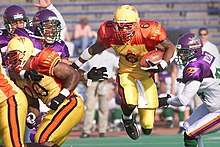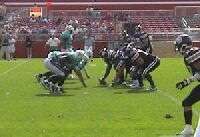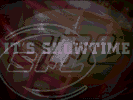Spring Football League
The Spring Football League (SFL) was a professional American football league that existed for only part of one mini-season in 2000. Founded by several ex-NFL players such as Eric Dickerson, Drew Pearson, Bo Jackson, and Tony Dorsett, the SFL planned to use the four-game mini-season (dubbed "Festival 2000") to test cities, fans, stadiums, the media, entertainment, and springtime American football as a product. The year before, the Regional Football League staggered through a spring season, then announced it would not return for 2000.
 | |
| Sport | American football |
|---|---|
| Founded | 2000 |
| Ceased | 2000 |
| Commissioner | Bill Futterer |
| Last champion(s) | San Antonio Matadors, Houston Marshals |




In late 1999, the SFL announced an inaugural season of 2000, with ten individually-owned teams playing a 12-week schedule, followed by a championship game during Memorial Day weekend. Mark Rice, chairman of the SFL board of governors, placed eight of the franchises in Birmingham, Canton, Ohio, Houston, Jackson, Mississippi, Los Angeles, Miami, San Antonio and Washington, D.C. Nothing more was heard until March 1, 2000, when the SFL announced the league had scaled down to four teams that would play four-game schedules on Saturdays from April 29, followed by a championship game in Miami on May 27.[1]
Teams
| Team | City | Stadium | Head coach |
|---|---|---|---|
| Houston Marshals | Houston, Texas | Robertson Stadium | Ray Woodard |
| Miami Tropics | Miami, Florida | Miami Orange Bowl | Jim Jensen |
| San Antonio Matadors | San Antonio, Texas | Alamo Stadium | Brian Wiggins |
| Los Angeles Dragons | Los Angeles, California | Los Angeles Memorial Coliseum | Doug Cosbie |
SFL teams consisted of 38 players, each of whom would receive $1,200 per game with a $200 winners bonus.
The league's games included pre-game and half-time shows featuring national musical acts (such as The O'Jays, Mark Wills, and Poncho Sanchez), a pronounced effort to attract both African-Americans and Latino fans, and innovative use of wireless communication.
SFL coaches of note:
- Lew Carpenter – Green Bay Packers
- Guy McIntyre – San Francisco 49ers
- Doug Cosbie – Dallas Cowboys
- Keith Millard – Minnesota Vikings
- Jim Jensen – Miami Dolphins
- Hugh Green – Miami Dolphins
- David Little – Pittsburgh Steelers
- Neal Colzie – Oakland Raiders
- Donald Hollas – Oakland Raiders
- Don Narcisse - Saskatchewan Roughriders
Mini-season cut short
Due to a lack of media coverage—the SFL had no TV or radio contracts, and newspaper coverage was spotty at best—it quickly became obvious that the league was a sinking ship. Attendance was disastrously low, despite very competitive contests; only 1,100 people showed up at the one game played at cavernous Los Angeles Coliseum. The SFL wasn't even able to finish out its modest, one-month season—league officials ended the test program after only two weeks (and four games, none of which drew more than a few thousand people). Houston and San Antonio, both with 2–0 records, were declared league co-champions.
With funding for the league having been provided by tech-stock entrepreneurs, any chance that the SFL would return was scotched by the tech-market crash of 2000 and the subsequent announcement of the XFL by the WWF.
The last professional football game played at the Miami Orange Bowl was an SFL game: an estimated 3,650 fans watched on April 29, 2000 as the San Antonio Matadors defeated the Miami Tropics, 16-14.